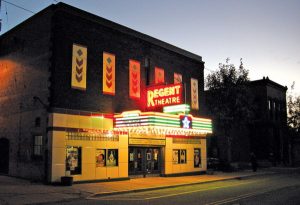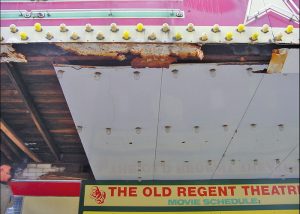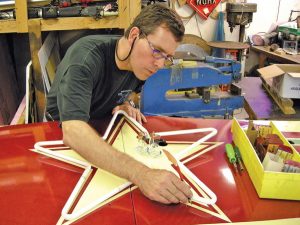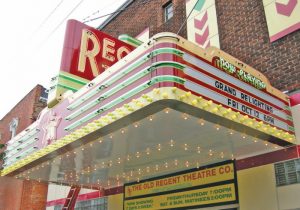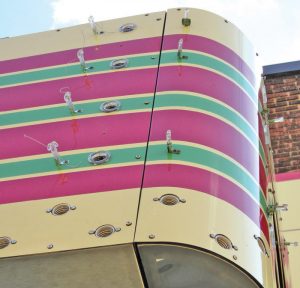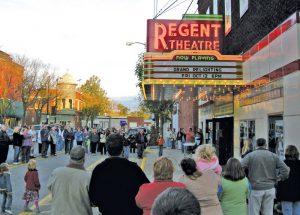Electric Signs
Allegan Alight
Published
14 years agoon
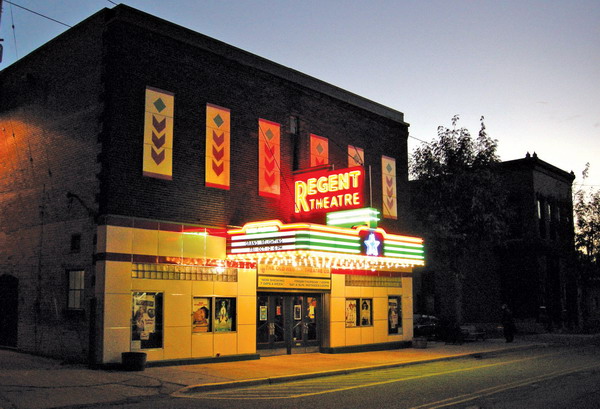
Jim Winter-Troutwine, a Grand Rapids, MI architect who specializes in restoring historical buildings, contacted me regarding a unique project for Allegan, a small town about 45 miles southwest of Grand Rapids. The city owned its local downtown movie theater and, using grant funding from the State of Michigan, wanted to restore the theater’s marquee and sign to their original condition. Allegan officials wanted the old theatre to serve as a central cog in downtown development while preserving the town’s well-known sense of history.
During my 25-year, neon-sign career, this was certainly the first time a customer possessed the funds and motivation to completely re-do a sign – let alone consider it “historic.” Back in the ’80s, it seemed people couldn’t tear down vintage, porcelain-enamel signs quickly enough. As a collector and sign aficionado, I was thrilled at the opportunity to complete a “frame-off” restoration.
Onsite conditions
The 10 x 20-ft. marquee and 10 x 12-ft. sign appeared, at first glance, to be in fair condition. Considering they were built in 1936, they looked remarkably vital. It had what I considered classic, art-deco lines, 11W, yellow, incandescent chaser bulbs, backlit marquee panels and tasteful, clear, green and blue argon and neon accents.
However, the red porcelain enamel had badly faded, and, besides numerous rust stains, the bottoms of the cabinets had been repaired with 0.040-in.-thick, white aluminum some time ago. The original, galvanized sheetmetal was long gone. Because the cabinets were secured to a heavy, I-beam subframe and bolted together, the loss of the bottom pieces didn’t seem to impact the overall structural integrity.
AdvertisementAmazingly, all but three of the 52 units of neon worked, and most appeared original. The project also included refurbishing the original, white, porcelain-enamel ceiling. Roof-drainage problems had exacted extensive damage to these panels as well.
The project’s mission required restoration of the entire structure to its original condition. Anyone familiar with restoring cars knows how much work this means. Every brass nut, bolt, screw, panel and socket has to be original as possible, saving as much of the structure as possible in the process.
No quick fix
With all the necessary paperwork completed, the entire structure came down during a blinding, April snowstorm. We dismantled the sign as a single piece, but the 10 ceiling panels were individually removed, and the marquee comprised three separate cabinets. Once removed, the components’ rust eliminated most structural integrity.
We carefully catalogued and boxed all neon parts, noted installation methods and stored the fastening hardware. It’s one thing to tear down a sign; removing it with the intent of creating an exact replacement presents a much greater challenge.
AdvertisementThe contract called for October completion. When I agreed to the project, that seemed so far away. Within two weeks, we’d deconstructed the sign and sent the porcelain panels to Cherokee Porcelain (Knoxville, TN). This shop undertook the application of new porcelain coatings for the ceiling-panel faces, but needed several months because of a heavy backlog.
Working with the patterns of the original faces, we repaired the missing cabinet portions. We repaired its structure with patches of galvanized sheetmetal. We made one approved deviation from the original: a new, brushed-stainless-steel bottom, with drain holes! After having taken apart countless Holiday Inn porcelain signs during the ’80s, I understood the wisdom of using drainholes to allow water to pass easily through the structure.
Dealing with adversity
During mid-summer, Cherokee contacted us with bad news. The minerals used to produce the original porcelain coating were deemed incompatible with the modern minerals to be used for the overlay’s production. The process of discovering this wrecked several of the original panels.
The only solution: Cherokee had to refabricate every panel to precisely match the originals. They plotted out and digitized every single hole, radius and dimension for the laser equipment to cut and bend the metal. The deadline rapidly approached. The final complication was getting the red to match the original, which was tricky. The original yellow and green porcelain matched perfectly, but we lost several weeks during the fabrication process.
AdvertisementIn September, the panels finally arrived in good shape. With porcelain, one dent or pinch can ruin the panel. Rust encroaches where bare steel is exposed. No holes or modifications can be included after the coating is applied and baked on. Either it fits or it doesn’t; by nature, porcelain is very unforgiving. For-tunately, the panels fit the original cabinets very well.
However, the neon-housing holes all were just enough askew to render the carefully boxed neon useless. All 52 pieces, which comprise 475 linear ft., had to be repatterned and remade. We used Voltarc 15mm and 13mm clear, 12mm green and 12mm blue neon. We had only four weeks left before the state inspection. We carefully fitted and wired the neon with porcelain lightbulb sockets and France transformers throughout.
I found a supplier who carried #9855 front-mount sockets (with two “ears”) and brass screws to match the original, as well as Philips 11W, yellow bulbs. We used #300 open-back, neon housings, which I’ve found help prevent shorts in the rain and are especially helpful with UL 2161-compliant transformers. This time-consuming work quickly ate up four weeks. There’s no such thing as a project without problems, is there?
A bittersweet end
Installation went smoothly – the four main units matched up perfectly with the supporting I-beam. The blade sign aligned over the marquee exactly as the original had. With all wires connected, there’s nothing like the feeling of throwing the switch and seeing an illuminated sign come to life.
On the dedication day one week later, the city organized a formal lighting event to culminate the $42,000 project. It drew a sizable crowd, and the collective exclamation was very, very rewarding. It was like lighting up a Christmas tree for kids! It was doubly rewarding to have a porcelain-neon sign valued by the community and recognized by the State of Michigan as historic.
Sadly, this project became the last large neon sign built by NeonAmericana. After 26 years of specializing in neon signs, I’ve seen the market for neon almost completely disappear. My new company, Lumichron, specializes in building illuminated clocks. It was somehow fitting to conclude my old shop with the reconstruction of a classic, art-deco piece of real Americana.
Equipment and Materials
Components: Eighteen- and 24-gauge, galvanized sheetmetal, from building-supply stores; medium-base, porcelain sockets, from Leviton Products (Huntington Beach, CA), (877) 389-0000 or www.levitonproducts.com; porcelain-coated steel panels, from Cherokee Porcelain (Knoxville, TN), (865) 637-7833 or www.cherokeeporcelain.com
Lighting: Clear, green and blue neon tubing, from Voltarc (Waterbury, CT), (800) 962-6366 or www.voltarc.com; neon electrodes, from EGL (Berkeley Heights, NJ), (908) 508-1111 or www.egl-neon.com; outdoor transformers, from France (Fairview, TN), (800) 753-2753 or www.franceformer.com; tube supports, from FMS (Minneapolis), (952) 888-7976 or www.fmsneon.com; #300 electrode housings and #9855 front-mount sockets, from neon-supply houses; GTO wire, from Electrobits (Montreal, QC, Canada), (877) 567-2487 or www.electrobits.com; Philips 11W, yellow, incandescent bulbs, from lighting-supply stores; and four-channel lighting chaser, from Time-O-Matic (Meriden, CT), (203) 634-4431 or www.shinersigns.com/timeomatic/
Tools: Plasma-cutting torch and welding equipment, from industrial-equipment and building-supply stores; installation crane, from Postema Signs and Graphics (Grand Rapids, MI), (616) 455-0260 or www.postemasign.com
More About Ian
Two years after having graduated from Holland, MI’s Hope College with a bachelor’s degree in communication, Ian Macartney took a bold step by founding Neon Americana in 1983 in Grand Rapids. During his neon-sign career, Macartney helped Holiday Inn update its brand identity with neon signage, as well as numerous other volume and custom, electric-sign projects.
However, Macartney witnessed the gradual evaporation of the neon-sign market as LEDs have become an increasingly appealing sign-lighting option due to their low energy consumption and ease of use. In response, he shifted gears and currently serves as president of Lumichron, which manufactures outdoor and neon-lit clocks. For more information, visit www.lumichron.com.

SPONSORED VIDEO
Introducing the Sign Industry Podcast
The Sign Industry Podcast is a platform for every sign person out there — from the old-timers who bent neon and hand-lettered boats to those venturing into new technologies — we want to get their stories out for everyone to hear. Come join us and listen to stories, learn tricks or techniques, and get insights of what’s to come. We are the world’s second oldest profession. The folks who started the world’s oldest profession needed a sign.
You may like
Advertisement
Subscribe

Magazine
Get the most important news
and business ideas from Signsofthetimes Magazine.
Advertisement
Most Popular
-

 Tip Sheet4 days ago
Tip Sheet4 days agoAlways Brand Yourself and Wear Fewer Hats — Two of April’s Sign Tips
-

 Business Management2 weeks ago
Business Management2 weeks agoWhen Should Sign Companies Hire Salespeople or Fire Customers?
-

 Women in Signs2 weeks ago
Women in Signs2 weeks ago2024 Women in Signs Award Winners Excel in Diverse Roles
-

 Real Deal5 days ago
Real Deal5 days agoA Woman Sign Company Owner Confronts a Sexist Wholesaler
-

 Benchmarks18 hours ago
Benchmarks18 hours ago6 Sports Venue Signs Deserving a Standing Ovation
-

 Editor's Note1 week ago
Editor's Note1 week agoWhy We Still Need the Women in Signs Award
-

 Line Time2 weeks ago
Line Time2 weeks agoOne Less Thing to Do for Sign Customers
-

 Product Buying + Technology1 week ago
Product Buying + Technology1 week agoADA Signs and More Uses for Engraving Machines
